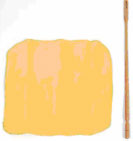How to Maintain your Flute?
 Moisture collected inside the flute after each playing session must be cleaned and removed. Take a soft cleaning cloth and pull it through the slit of your cleaning rod. Carefully push the rod through the body piece of your instrument, twisting the rod as you go so that the metal rod does not come into contact with the inside of your flute. Do the same for the headjoint and footjoint.
Moisture collected inside the flute after each playing session must be cleaned and removed. Take a soft cleaning cloth and pull it through the slit of your cleaning rod. Carefully push the rod through the body piece of your instrument, twisting the rod as you go so that the metal rod does not come into contact with the inside of your flute. Do the same for the headjoint and footjoint.
Never use any silver polishes on your instrument. Polishes strip precious silver from the surface of your flute, ruin your keypads and can badly damage the metal of your key system. Gently wipe down your flute with a soft cloth before and after playing. A clean mouth (rinse with water even after brushing to keep toothpaste residue out of the flute) will prevent discoloration of your flute - inside and out - as well as keep food particles from building up in keys.
If you have sticky pads, take a sheet of cigarette paper and place it beneath the sticky key. Gently push down, but with a little more pressure than when you play the keys. The idea is to wick the moisture out of the pad with the paper. Repeat as necessary, but be careful not to push down too hard or your pad may be worn. Prevent sticking keys by always rinsing your mouth with water before playing.
Don¡¯t forget to wipe the tenons (the places where your flute joints fit together) of your flute regularly. They accumulate grease and dirt, which make it difficult to connect the joints of your flute. The headjoint is particularly important to clean, as it is the weakest joint and can be easily damaged if forced into a sticky joint.
The embouchure hole of your headjoint should be cleaned regularly, and if you have an open-holed flute, remember to clean the holes of your keys. Particles can build up in these places and can easily be cleaned with a Q-tip; carefully push down the key and swipe with the Q-tip. Stubborn spots should still be approached gently, but to help, dampen (not soak!) the Q-tip slightly in rubbing alcohol. Use only the rubbing alcohol, not water or other forms of alcohol, including aftershave, as they will damage the keypads.
Damage Prevention
1. Keep your flute clean! Moisture buildup on the inside of your flute can cause damage of pads which will have to be replaced, and corrosion of the inside, cause your sound not to be as full. After every playing session, be sure to clean the inside of your flute and wipe any fingerprints off of the outside. If it starts getting corroded, send it in to a professional cleaner right away.
2. When you are leaving your flute anywhere, make sure it is in a safe place! Put it somewhere where it¡¯s not going to get knocked down, or put it away. Never keep your flute in extreme temperatures or conditions for any length of time!
While putting it together, be sure not to grasp it too tightly, and not to hold it by the keys and rods; this does extreme damage to your flute over time.
3. Take your flute in for a check-up around once or twice a year. Any alignment problems, internal problems or corrosion will be noted and fixed.
Always remember, to prevent damage in the first place, keep your flute clean, safe, and in good health
Self-Repair
1. Depending on what kind of flute you have, it will have tiny flathead screws at various points. On simpler models, there will only be screws on the end of the rods. Some flutes have individual screws for every key though, which makes it much easier to fix. If you are planning on doing self-repair, go to your local music store and buy a tiny, flathead instrument screwdriver.
2. The problem will be quite obvious when a spring is not in its proper place, as the keys that are supposed to move up and down will not and many of your notes will not play. To fix a spring, take a pen, a small screw-driver, or something long and slender and push it back into place (you¡¯ll notice that it¡¯s out of place if it looks like its bent because it¡¯s on the wrong side of the little catch that holds it). It is very tedious to fix this, but sometimes it¡¯s not worth sending it into a repair shop if it¡¯s just a little out of place.
2. The problem will be quite obvious when a spring is not in its proper place, as the keys that are supposed to move up and down will not and many of your notes will not play. To fix a spring, take a pen, a small screw-driver, or something long and slender and push it back into place (you¡¯ll notice that it¡¯s out of place if it looks like its bent because it¡¯s on the wrong side of the little catch that holds it). It is very tedious to fix this, but sometimes it¡¯s not worth sending it into a repair shop if it¡¯s just a little out of place.
